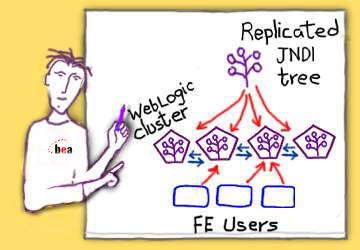


"Let's look at how WebLogic Server clusters work. I think WebLogic Server has the most sophisticated clustering model in the application server industry!" the Java engineer said. "A cluster of WebLogic Servers supports both load balancing and failover of JNDI-based objects and HTTP servlets. We'll be able to plug in our own custom load handlers -- although WebLogic Server offers built-in load handlers for different application scenarios that may suit our needs right out of the box. Best of all, load balancing is all completely transparent to the user -- when one of the call support engineers signs in, his request will be routed dynamically to an available server. And we can configure and tune the load balancing for optimum performance."
"So what happens if one of the servers goes down?" Mr. Imayess asked. "Do all of its clients go down with it?"
The Java engineer stepped up to the whiteboard again. "No, WebLogic Server handles server failure in a cluster transparently; another server will take over the workload for the server that's down without any interruption of service.
"Yeah, sure," Mr. Imayess said cynically. "What if the main server goes down? The one that knows how to route all those service requests?"
"It's a good question," the Java engineer acknowledged. "But the answer is easy -- can't happen. There's no single point of failure in a WebLogic Server cluster -- the servers in the cluster are peers. Each server has a copy of a cluster-wide JNDI tree. As new services are bound into the tree that information is replicated across the cluster. If one server in the cluster fails, the replicated JNDI tree is updated instantly, and everything keeps on working."
"That's pretty impressive," Ms. Veep said. "Is there a big overhead for that kind of reliability?"
"Performance-wise WebLogic Server is just as fast in a cluster as it is in a single-server configuration. WebLogic Server uses a technology they call "SmartStubs" to generate clusterable stubs that are both more efficient in the normal case and know how to failover."
"I like what I see so far," Mr. Imayess allowed. "But how will I produce reports for my department? Number of open calls, priority, information about the whole organization?"
"Well, we can write customized browser-based reports very easily with JSP. But we've got some other things to show you that I think you'll like. Let's explore the application further," the Java engineer said.